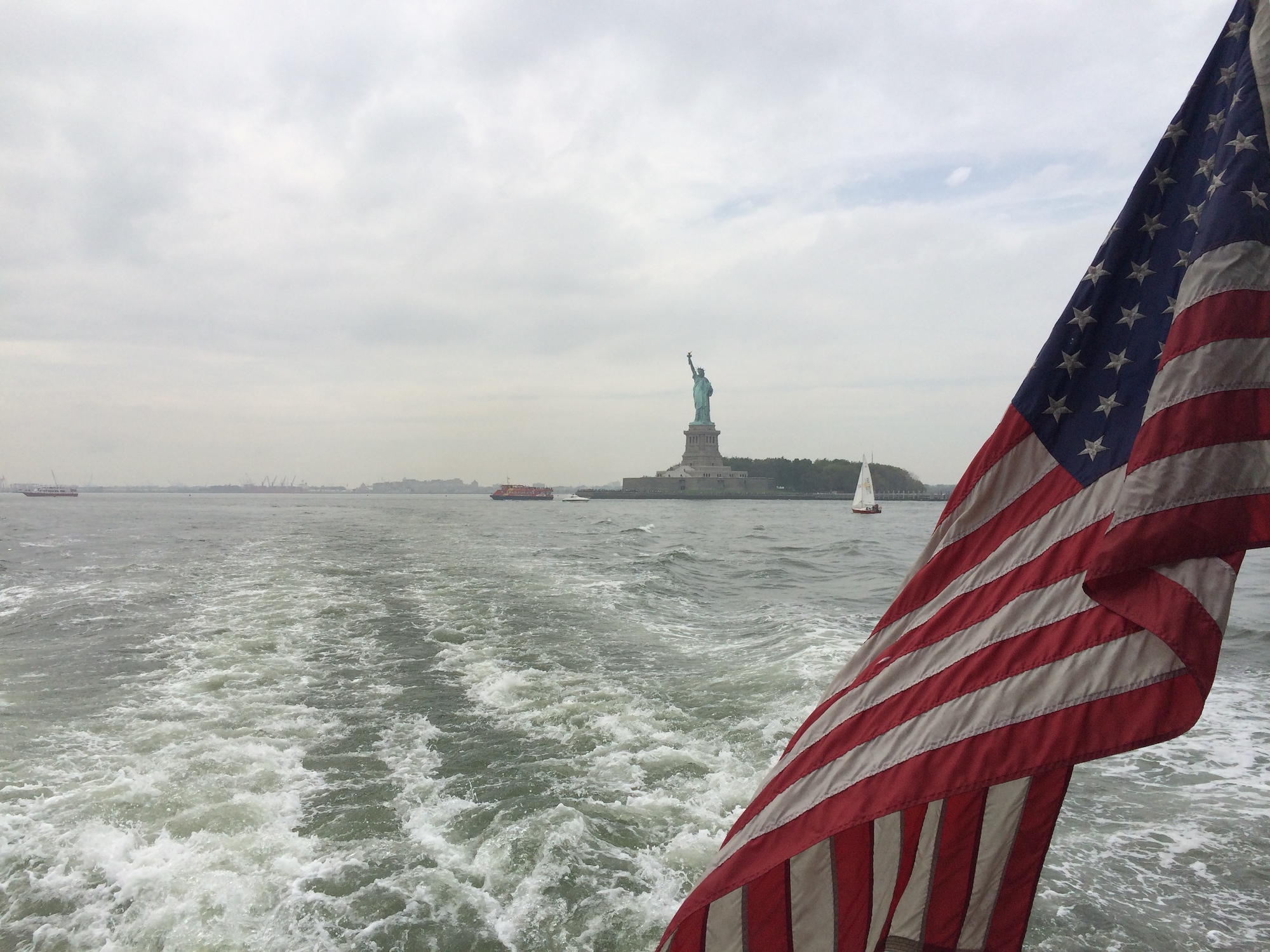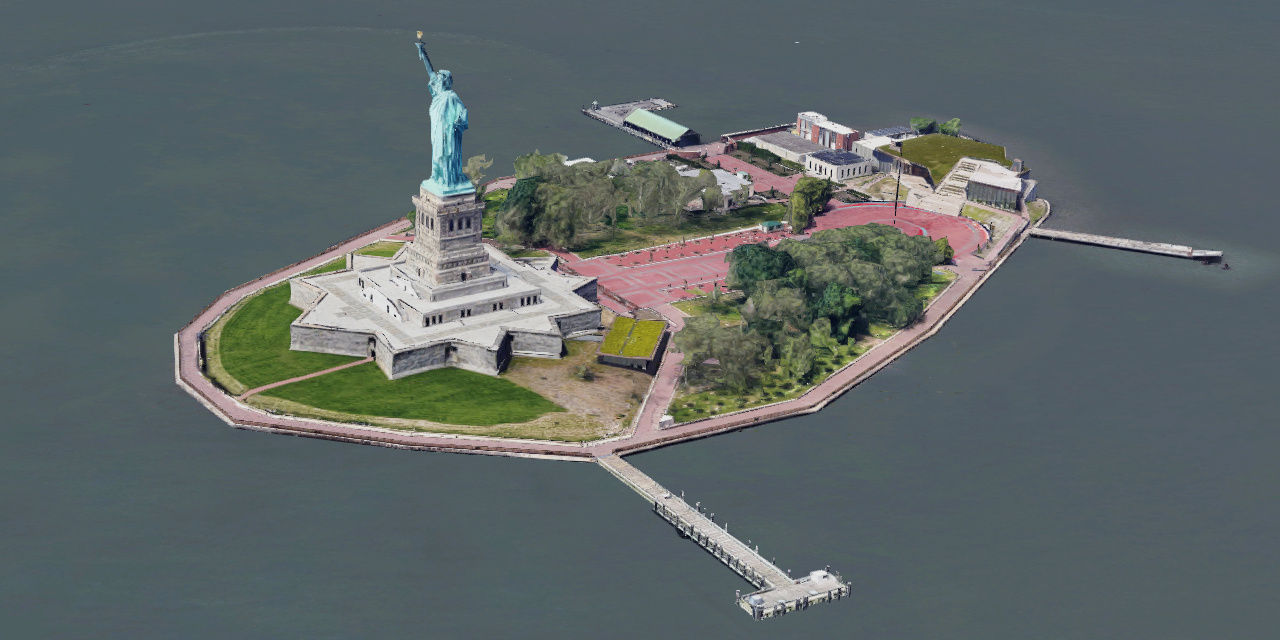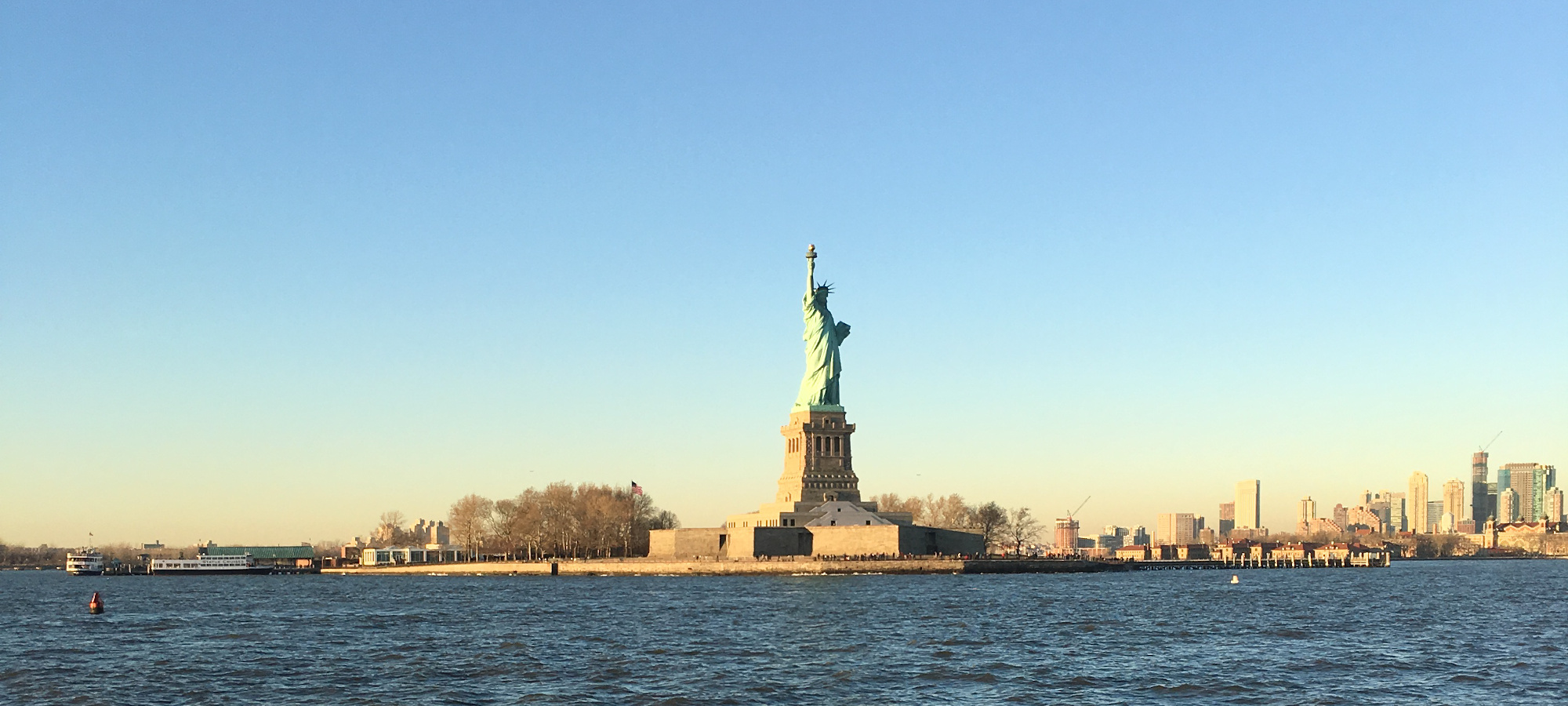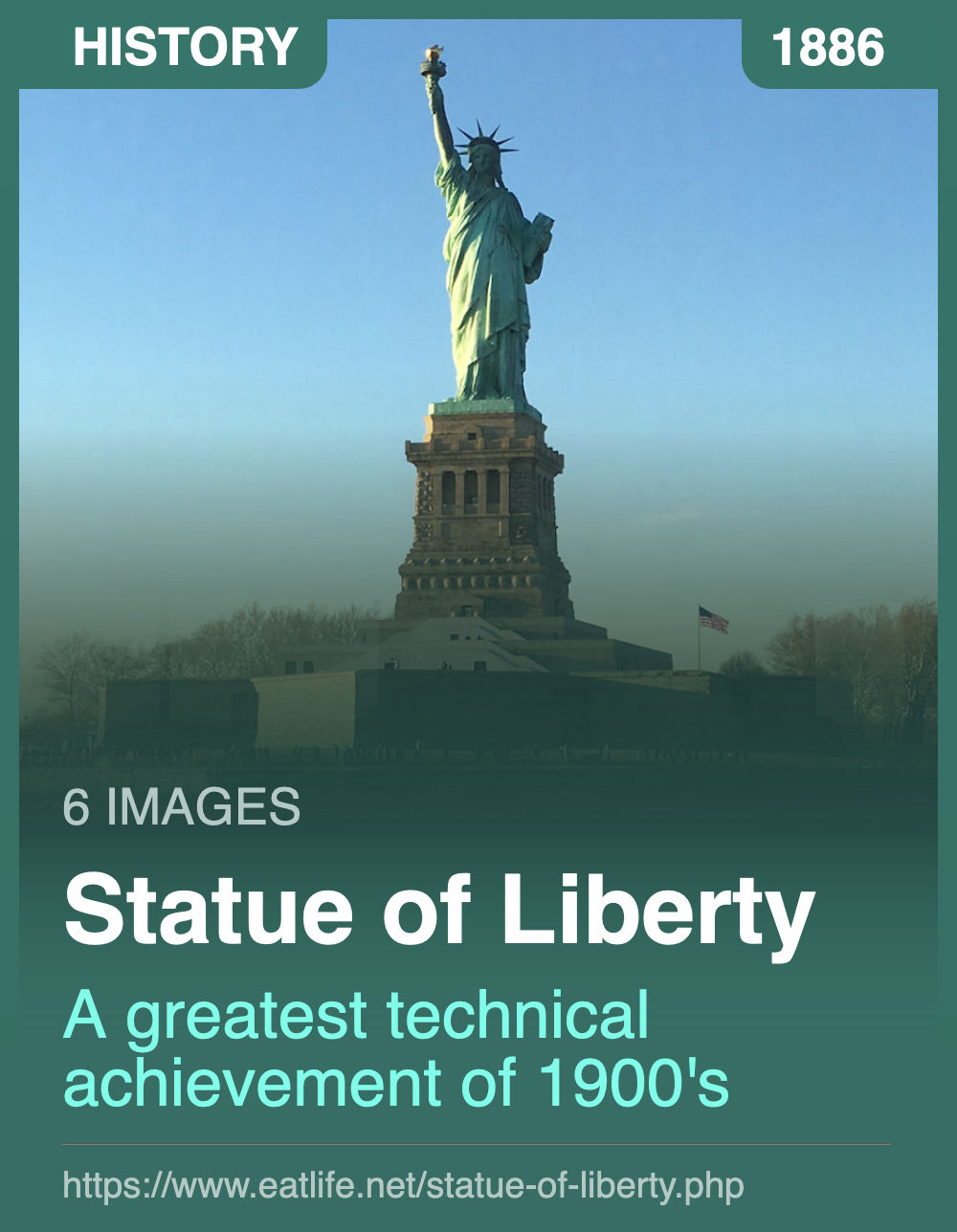The Statue of Liberty was built in France:
It was presented to the United States on July 4, 1884 as a birthday gift. It was then taken apart, shipped across the Atlantic Ocean in crates, and rebuilt in the U.S. It was France's gift to the American people.It all started at dinner one night near Paris in 1865. A group of Frenchmen were discussing their dictator-like emperor and the democratic government of the U.S. They decided to build a monument to American freedom.
At that dinner was the sculptor Frederic-Auguste Bartholdi. He imagined a statue of a woman holding a torch burning with the light of freedom. Turning Bartholdi's idea into reality took 21 years. French supporters raised money to build the statue, and Americans paid for and built the pedestal it would stand on. Finally, in 1886, the statue was dedicated.
Some Facts:
- The statue sways 3 inches in the wind; the torch sways 5 inches.
- Visitors climb 354 steps to look out from 25 windows in the crown.
- The statue—151 feet, 1 inch tall. It was the tallest structure in the U.S. at that time.
- Inside the statue four huge iron columns support a metal framework that holds the thin copper skin.
Engineer Gustave Eiffel, who would later design the Eiffel Tower in Paris, designed all the metal framework inside.
- Frederic-Auguste Bartholdi knew he wanted to build a giant copper goddess; he used his mother as the model.
- The statue is covered in 300 sheets of coin-thin copper. They were hammered into different shapes and riveted together.
- The arm with the torch measures 46 feet; the finger, 8 feet; the nose, nearly 5 feet.
- Seven rays in the crown represent the Earth's seven seas.
https://kids.nationalgeographic.com/history/article/statue-of-liberty


The Roman goddess Libertas and Sol Invictus ("The Unconquered Sun") both influenced the Statue of Liberty
https://en.wikipedia.org/wiki/File:Disc_Sol_BM_GR1899.12-1.2.jpg
- Her torch represents liberty
- In Roman numbers, her tablet reads July 4, 1776, America's independence day
- Her crown has 25 windows, recognizing the gemstones found on the earth
- The rays of her crown symbolize the seven continents and seven seas
- At her feet are chains, representing the tyranny of colonial rule from which America escaped
https://www.state.nj.us/nj/about/resources/statue_of_liberty.html
| Statistics | |
|---|---|
| https://www.state.nj.us/nj/about/resources/statue_of_liberty.html | |
| 305 feet | Height from the ground to the tip of torch |
| 111 feet | Height from the heel to the top of the head |
| 154 feet | Height of the pedestal |
| 354 | Number of steps to the crown |
| 192 | Number of steps to the top of the pedestal |
| 62,000 | Pounds of copper in the statue |
| 250,000 | Pounds of steel in the statue |
| 54,000,000 | Pounds of concrete in foundation |
| 3/32 of an inch | Thickness of the copper sheeting of the statue |

Lady Liberty's crown has 25 windows, recognizing the gemstones found on the earth
- Agate
- Alexandrite
- Amethyst
- Aquamarine
- Beryl
- Carnelian
- Chrysoberyl
- Diamond
- Emerald
- Emery
- Garnet
- Jade
- Lapis Lazuli
- Moonstone
- Onyx
- Opal
- Peridot
- Ruby
- Sapphire
- Spinel
- Tanzanite
- Topaz
- Tourmaline
- Turquoise
- Zircon

The French sculptor Frederic-Auguste Bartholdi created the statue itself out of sheets of hammered copper, while Alexandre-Gustave Eiffel, the man behind the famed Eiffel Tower, designed the statue's steel framework. The Statue of Liberty was then given to the United States and erected atop an American-designed pedestal on a small island in Upper New York Bay, now known as Liberty Island, and dedicated by President Grover Cleveland in 1886.
Over the years, the statue stood tall as millions of immigrants arrived in America via nearby Ellis Island. In 1986, it underwent an extensive renovation in honor of the centennial of its dedication. Today, the Statue of Liberty remains an enduring symbol of freedom and democracy, as well as one of the world's most recognizable landmarks.
1865:
As the American Civil War drew to a close, the French historian Edouard de Laboulaye proposed that France create a statue to give to the United States in celebration of that nation's success in building a viable democracy.
The sculptor Frederic Auguste Bartholdi, known for largescale sculptures, earned the commission.
The goal was to design the sculpture in time for the centennial of the Declaration of Independence in 1876.
The project would be a joint effort between the two countries–the French people were responsible for the statue and its assembly, while the Americans would build the pedestal on which it would stand.
Due to the need to raise funds for the statue, work on the sculpture did not begin until 1875.
Bartholdi's massive creation, titled "Statue of Liberty Enlightening the World," depicted a woman holding a torch in her raised right hand and a tablet in her left, upon which was engraved "July 4, 1776," the adoption date of the Declaration of Independence.

Bartholdi, who was said to have modeled the woman's face after that of his mother, hammered large copper sheets to create the statue's "skin" (using a technique called repousse).
To create the skeleton on which the skin would be assembled, he called on Alexandre-Gustave Eiffel, designer of Paris' Eiffel Tower. Along with Eugene-Emmanuel Viollet-le-Duc, Eiffel built a skeleton out of iron pylon and steel that allowed the copper skin to move independently, a necessary condition for the strong winds it would endure in the chosen location of New York Harbor. Designed by the American architect Richard Morris Hunt, the statue's pedestal was constructed inside the courtyard of Fort Wood, a fortress built for the War of 1812 and located on Bedloe's Island, off the southern tip of Manhattan in Upper New York Bay.
While work went on in France on the actual statue, fundraising efforts continued in the United States for the pedestal, including contests, benefits and exhibitions. Near the end, the leading New York newspaperman Joseph Pulitzer used his paper, the World, to raise the last necessary funds.
In 1885, Bartholdi completed the statue, which was disassembled, packed in more than 200 crates, and shipped to New York, arriving that June aboard the French frigate Isere. Over the next four months, workers reassembled the statue and mounted it on the pedestal; its height reached 305 feet (or 93 meters), including the pedestal. On October 28, 1886, President Grover Cleveland officially dedicated the Statue of Liberty in front of thousands of spectators.
The statue's completion was marked by New York's first ticker-tape parade and a dedication ceremony presided over by President Grover Cleveland

Looking down from inside the crown
Public access to the balcony around the torch has been barred since 1916
Funding the Dream:
To raise funds in France, public fees, various forms of entertainment, and a lottery were used. In the U.S., to finance the pedestal, benefit theatrical events, art exhibitions, auctions, and prizefights were held. Poet Emma Lazarus wrote her famous sonnet The New Colossus in 1883 for an art and literary auction.Despite these efforts, fundraising for the pedestal went slowly. To spark public action, in 1885, Joseph Pulitzer placed an ad in his paper the New York World inviting readers to donate to the cause. In exchange, Pulitzer printed each donor's name in the newspaper. The public rose to the challenge with 120,000 people donating over $100,000 and securing the remaining funds needed for the Statue's pedestal.
Crossing the Atlantic:
For its trans-Atlantic voyage aboard the frigate Isere, the Statue was reduced to 350 individual pieces and packed in 214 crates. The ship arrived in New York Harbor on June 17, 1885. While awaiting construction of its pedestal, the Statue remained in pieces on what was then called Bedloe's Island. The pedestal was completed in April 1886 and finally, on October 28, 1886, President Grover Cleveland oversaw the dedication of the Statue of Liberty in front of thousands of spectators.Bedloe's Island:
The story of the Statue of Liberty and her island has been one of change. For centuries the island was a major source of food for the Lenape native people and later Dutch settlers. In 1807, the U.S. Army deemed the island a military post, constructing an 11-point fort to protect New York Harbor. Later renamed Fort Wood, the structure now serves as the base for the Statue's pedestal.The Statue's own meaning and relevance have evolved with time, as well. Perhaps most notable is the association with welcoming "huddled masses." In 1903, a plaque baring "The New Colossus" was placed in the pedestal. With that Lady Liberty's significance grew as an inspiration to immigrants who sailed passed her on their way to America.
https://www.statueofliberty.org/statue-of-liberty/overview-history
Fort Wood was a disused army base on Bedloe's Island that was constructed between 1807 and 1811. Since 1823, it had rarely been used. The fortifications of the structure were in the shape of an eleven-point star.
The New Colossus:
By Emma Lazarus 1883
Not like the brazen giant of Greek fame,
With conquering limbs astride from land to land;
Here at our sea-washed, sunset gates shall stand
A mighty woman with a torch, whose flame
Is the imprisoned lightning, and her name
Mother of Exiles. From her beacon-hand
Glows world-wide welcome; her mild eyes command
The air-bridged harbor that twin cities frame.
"Keep, ancient lands, your storied pomp!" cries she
With silent lips. "Give me your tired, your poor,
Your huddled masses yearning to breathe free,
The wretched refuse of your teeming shore.
Send these, the homeless, tempest-tost to me,
I lift my lamp beside the golden door!"https://www.poetryfoundation.org/poems/46550/the-new-colossus


The inner structure of the Statue of Liberty is an iron skeleton engineered by Gustav Eiffel.
Eiffel's design made the statue one of the earliest examples of curtain wall construction, in which the exterior of the structure is not load bearing, but is instead supported by an interior framework.

https://en.wikipedia.org/wiki/File:Head_of_the_Statue_of_Liberty_on_display_in_a_park_in_Paris.jpg

As Bartholdi envisioned it in 1874, the flame of the Statue's torch was not to be lighted but rather made of solid copper sheet and gilded to shine brightly in daylight. But in during its first half-century, the torch underwent numerous modifications. When the Statue was dedicated in 1886, two rows of portholes had been cut from the copper at the bottom of the torch to illuminate it from inside.
Six years later, an 18-inch belt of glass replaced the upper row of portholes and an octagonal pyramidal skylight with red, white and yellow glass was installed on top of the flame. Changes continued in 1916 when copper was removed in about 250 places and replaced with amber-colored cathedral glass. In 1931 a new lighting system was installed that called for two holes 16 inches in diameter to be cut into the floor of the balcony around the flame through which two projectors were installed. By this time, Bartholdi's design was barely recognizable.
In the 1980s when the Foundation was restoring the Statue for its centennial celebration, a team of experts determined that the original torch could not be restored. A century of modifications had radically altered Bartholdi's solid copper flame to one mainly of glass. Leaks from rain and corrosion from the elements had damaged the original torch above the handle beyond repair. It was removed on July 4, 1984 and replaced with a replica that followed Bartholdi's design.
Today, the original torch is on display in the Inspiration Gallery of the Statue of Liberty Museum.
https://www.statueofliberty.org/statue-of-liberty/overview-history
The Statue of Liberty, a hollow colossus composed of thinly pounded copper sheets over a steel framework, stands on an island at the entrance to New York Harbor. It was designed by sculptor Frederic Bartholdi in collaboration with engineer Gustave Eiffel, and was a gift from France on the centenary of American independence in 1876. Its design and construction were recognized at the time as one of the greatest technical achievements of the 19th century and hailed as a bridge between art and engineering. Atop its pedestal (designed by American architect Richard Morris Hunt), the Statue has welcomed millions of immigrants to the United States since it was dedicated in 1886.

https://www.google.com/maps/place/Statue+of+Liberty+National+Monument


It might be closer to New Jersey and surrounded by the waters of New Jersey but technically it is located within the territorial jurisdiction of the State of New York
https://www.google.com/maps/place/Statue+of+Liberty+National+Monument

https://www.google.com/maps/place/Statue+of+Liberty+National+Monument
 https://www.nps.gov/stli/index.htm
https://www.nps.gov/stli/index.htm
Liberty Island
New York, NY 10004













